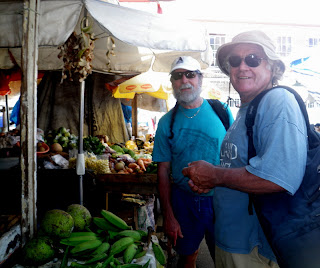In an effort to visit the rest of the island before Jim’s departure north, we decided to brave the act of driving on the left and take a tour of the island.
I will have to save up for that as I already blew the diving budget in Carriacou!
We headed into the Grand Etang National Forest for the trek to the remote Seven Sisters Falls, high in the central mountains of the island.
A two hour hike roundtrip, fairly steep and requiring a $5EC admission price across private farmland, this spot was Garden of Eden beautiful.
The owner of the farm access handed out walking sticks with the price of admission and they came in very handy especially on the return uphill trail.
Next stop was the Belmont Estate on the north end of the island. A former colonial sugar cane plantation, Belmont Estate dates back 300 years and is now the site of the Grenada Organic Chocolate Factory production.
Cocoa beans are brought here from surrounding farms and processed by hand.
The estate is still owned privately with the owner’s home on site, a restaurant serving local Creole cooking, a goat dairy, museum, and orchid farm.
The tour starts with a visit to the plantation bell, used originally to call slaves in from the fields, it hangs from a centuries old tamarind tree.
This ancient tree was said to be the “hanging” tree and each tamarind seed, unique in size and shape, a mournful representation of those who met their end from its limbs.
Cocoa seeds are foot polished in the sun to protect the fragile oils, a practice known as “dancing with the beans”.
Nutmeg and mace are also dried and processed on site.
Restored ruins and beautiful gardens invited walking and roaming.
This is the site where hundreds of Caribe Indians voluntarily jumped to their deaths rather than submit to the French invaders in 1650.
A beautiful view for an ancient Catholic cemetery with one surprising tenant.
For Jim and I this was especially interesting as we both had numerous experience with patients afflicted with the devastating and painful disease of sickle cell anemia.
Heading back to the boat on the deserted west coast road in time for a cold beer, we had completely circumnavigated this interesting island with rich history, beautiful landscapes and good company.























